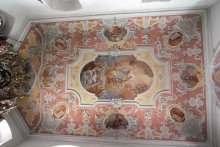Himmelfahrt Mariens
Inschrift: Inschrift: DeI GenItrIX sVper Choros AngeLorVm eXaLtata
Inschrift: Inschrift: DeI GenItrIX sVper Choros AngeLorVm eXaLtata
Spruchband [teilweise verdeckt vom Altar]: Oculi mei erunt apert … ad orationem eius qui in lo.. sto.. uern…. alip. 7.
MANGA ERIT GLORIA DOMUS ISTIUS NOVISSIMAE PLUSQUAM PRIMAE Agai. 2
SANCTIFICAVI DONUM HANC QUAM AEDIFI CASTI 3. Reg. 9.
DOMUS MEA DOMUS ORATIONIS VOCABITUR Isai. 50
VENITE ASCENDAMUS AD DONUM DEI IACOB Isai. 2.

Inschrift: Inschrift: DeI GenItrIX sVper Choros AngeLorVm eXaLtata
Spruchband [teilweise verdeckt vom Altar]: Oculi mei erunt apert … ad orationem eius qui in lo.. sto.. uern…. alip. 7.
MANGA ERIT GLORIA DOMUS ISTIUS NOVISSIMAE PLUSQUAM PRIMAE Agai. 2
SANCTIFICAVI DONUM HANC QUAM AEDIFI CASTI 3. Reg. 9.
DOMUS MEA DOMUS ORATIONIS VOCABITUR Isai. 50
VENITE ASCENDAMUS AD DONUM DEI IACOB Isai. 2.
Zuletzt aktualisiert am: 18.06.2014
Nirgendwo hat der Barock eine solche Dichte an Allegorien der vier Erdteile – Europa, Asien, Afrika und Amerika – hervorgebracht wie im Süden des Heiligen Römischen Reiches. In ihnen manifestieren sich die Vorstellungen des Barock von der Gestalt der Welt, ihrer politischen, sozialen und spirituellen Ordnung, vom Fremden wie vom Bekannten. Diese einzigartige Sammlung dokumentiert Darstellungen der vier Erdteile in Fresken, Stuck, Gemälden oder Skulpturen in ihren ursprünglichen Ausstattungskontexten. Baugeschichten sind ebenso erfasst wie Künstler und Auftraggeber.
Publikationen zum Projekt:
***
Allegories of the four continents – Europe, Asia, Africa, and America – were an extremely popular iconographic motive during the baroque era. It was most prevalent in the Southern Parts of the Holy Roman Empire. These allegories express/manifest/carry the imagination/conception/vision of the baroque of the shape of the world, its political, social, and spiritual order as well as of foreign and familiar things. This unique collection documents depictions of four continents in frescoes, stucco, paintings or sculptures in their place of origin. The historical contextualization contains the building history as well as artists and principals.
New publications: